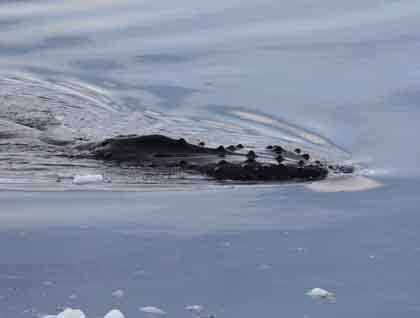This morning at the crack of dawn the National Geographic Explorer left it’s snug position parked in the fast ice off Port Lockroy on Wiencke Island. Heading south for the Lemaire Channel most of us awoke to the sounds of ice against the hull as we penetrated the residuals of particularly heavy sea ice from last winter’s record coverage. An incredible scene surrounded us as the glacial amphitheatre that makes the Antarctic Peninsula so extraordinary was made even more spectacular with all the ice in the water, the crabeater seals on ice, and the whales all around us. Orca whales were spotted briefly amongst the ice and humpbacks gave us quite the show. At one point the humpbacks were so close you could see the tubercles (small bumps) on their rostrums and hear them breathing. Shortly after leaving the baleen feeders to consume the krill that sustains all life below the convergence, we encountered the toothed variety that everyone hopes to see. Orcas of the Gerlache variety were spotted in various directions around the ship and under the bow at one point. A minke whale in the mix we thought perhaps we were going to see some carnage but learned that this variety of orca prefer to play with minkes vs consume them as they have a preference for penguins in these parts. After an incredible morning of cruising we made a continental landing at Neko Harbor after lunch. Neko Harbor, named after a floating whale factory ship (Neko), operated in the South Shetland Islands and Peninsula in 1911 and 1923 and often visited this area. The cascading glacier into Andvord Bay provided an incredible backdrop for the gentoo colonies and folks on Zodiac cruises and on land got to experience some calving from the glacier descending from the Laussedat Heights. In and among the mix of gentoos, one lone chinstrap and one Adelie allowed us to view all three species of brushtails at this landing. Back on the ship we enjoyed a few presentations before recap and after dinner we were blessed by beautiful light, calm waters, and the company of humpbacks.
3/12/2025
Read
National Geographic Endurance
At Sea towards Ushuaia
It was a day for reflection. Our journey was coming to an end as we left the Falklands behind and National Geographic Endurance steamed towards South America and Ushuaia. The seas were kind to us, and despite low winds, we had black-browed albatross, among other birds, around us. In the morning, we listened to the naturalists onboard as they presented on different subjects in the ice lounge. Land-ho! Mid-morning we had land in sight, South America was appearing on the horizon. Upon entering the Beagle Channel, we saw possibly a hundred sei whales. While the seabirds were waiting for the wind on the surface, the whales were feeding a short distance from the ship. As our vessel waited for the pilot to arrive, we could still see whale blows in the distance. We enjoyed a teatime extravaganza with Chef Sara and her team. Cheese and wine brought most of the ship’s inhabitants to deck 8, and while sipping wine we watched sea lions, dolphins, and stunning views of Tierra del Fuego go by until it was time for Captain Aaron’s farewell toast. As much as we are reflecting on our expedition today, it has also been a day of celebration! It has been an incredible journey of many miles, great people, and wonderful experiences. Thank you all!









